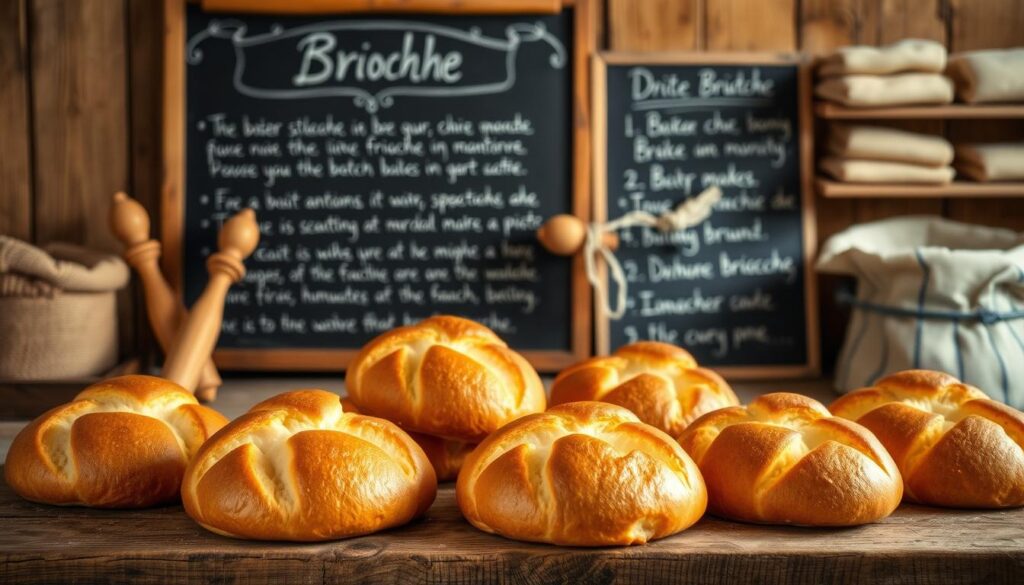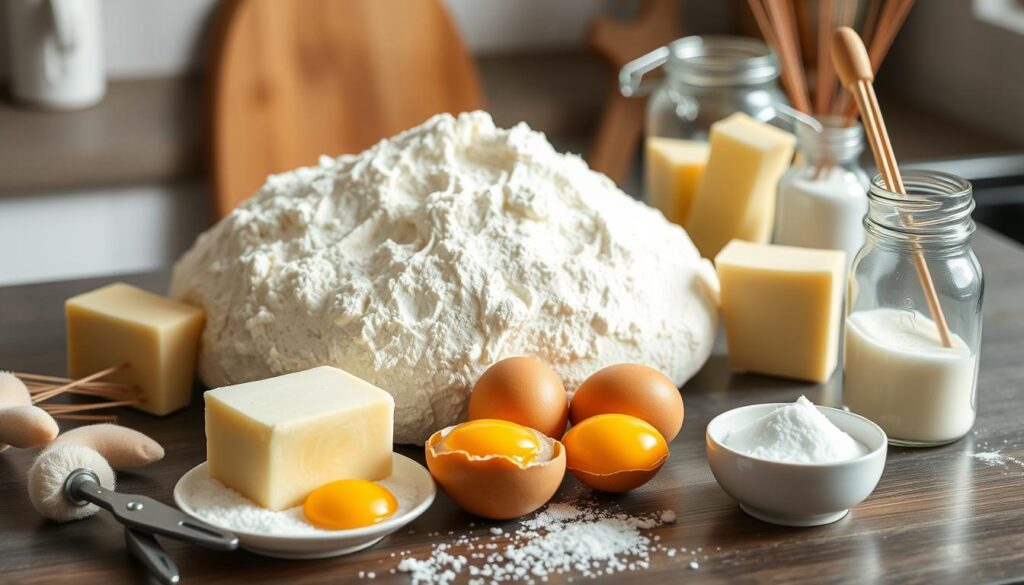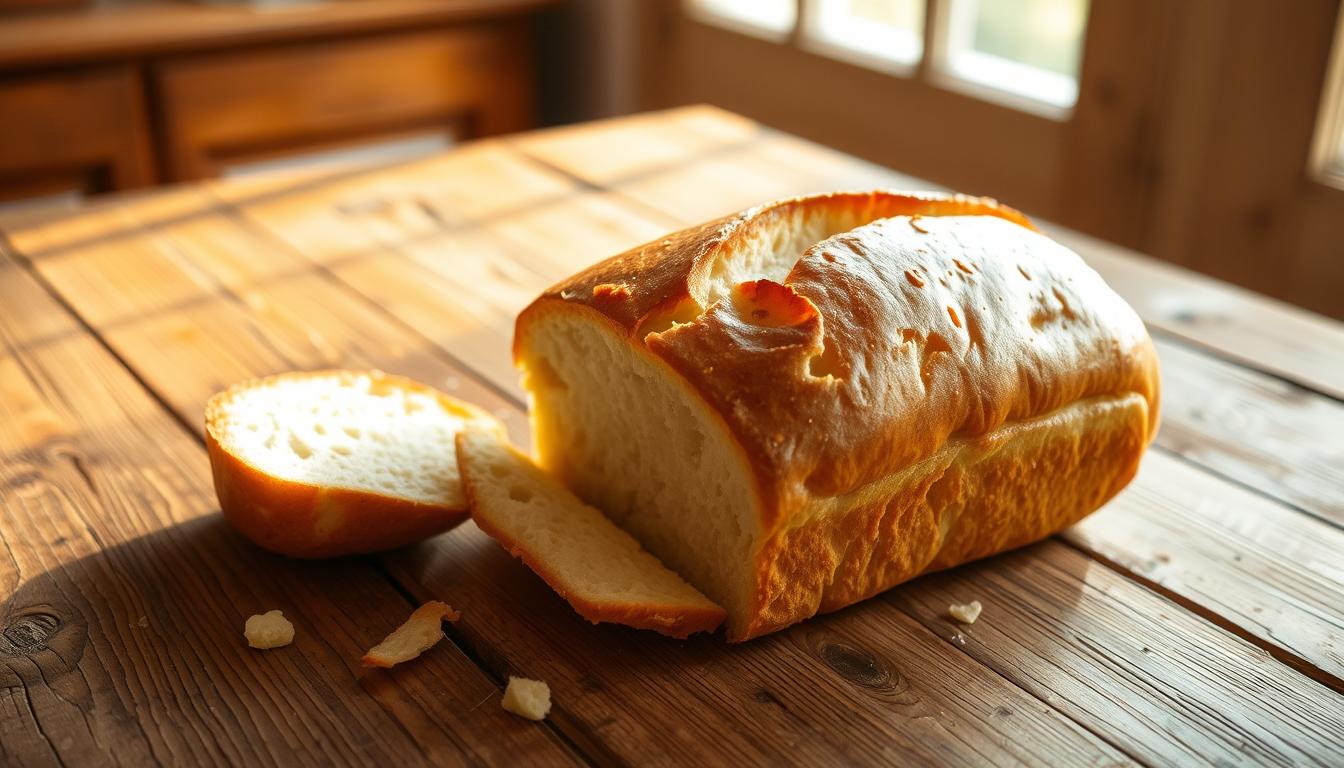Brioche Bread Recipe: Every kitchen has its special moments. Making homemade brioche bread is like leading a culinary symphony. The first time I took a golden, buttery French bread out of the oven, I knew it was something special.
Brioche is more than just bread. It’s a luxurious treat that makes any meal unforgettable. This French bread recipe offers a texture so soft and rich, it melts in your mouth with every bite.
Whether you’re an experienced baker or just starting out, making your own brioche bread opens up a world of flavors. It’s perfect for French toast or gourmet sandwiches, making your cooking even better.
Key Takeaways
- Discover the art of creating authentic French brioche
- Learn professional techniques for soft, buttery bread
- Understand the science behind perfect bread texture
- Explore multiple serving suggestions
- Master a recipe that impresses both family and guests
Understanding the History and Origins of Brioche
Explore the world of brioche, a bread with a long and interesting history. It started as a royal treat in France and is now loved by many around the world.

French Heritage and Royal Connections
Brioche first appeared in 15th century France. It quickly became known for its fine taste. The bread comes from Normandy, famous for its butter and baking skills.
Online talks about brioche have grown by 15% lately. This shows how much people love it.
The name « brioche » possibly comes from the Old French word « brier, » meaning « to knead. » This shows the bread’s handmade origins.
Evolution from Luxury to Everyday Bread
What was once a special treat for French nobles is now enjoyed by all. The story of brioche is quite amazing:
- It was first served at royal banquets.
- It was seen as a luxury food.
- Now, it’s a bread that everyone loves.
Traditional Significance in French Baking
In France, brioche is more than just bread. It’s a work of art. With over 30 types in France and a 20% rise in new brioche products each year, it’s a favorite worldwide.
Today, brioche is more than a food. It’s a symbol of French culinary tradition. It’s enjoyed in fancy restaurants and home kitchens alike, thanks to its rich flavor and versatility.
Essential Ingredients for Perfect Brioche
Making great brioche starts with picking the right ingredients. The ingredients you choose will affect the bread’s taste and texture. Brioche is different from regular bread because it needs special ingredients for its rich flavor.

The key to a fantastic brioche is in the ingredients. High-quality butter is crucial for its unique taste and softness.
- Bread Flour: 4 cups (500 grams) of premium flour
- Active Dry Yeast: 1½ tablespoons (15 grams)
- Whole Milk: 1 cup (250 grams)
- Sugar: ¼ cup (50 grams)
- Eggs: 6 large eggs
- Butter: 1 stick (113 grams) of premium salted butter
Each ingredient adds something special to the brioche. Eggs give it a rich color and soft texture. The high-quality butter makes it melt in your mouth.
| Ingredient | Quantity | Purpose |
|---|---|---|
| Bread Flour | 4 cups | Provides structure and strength |
| Butter | 1 stick | Adds richness and flavor |
| Eggs | 6 large | Creates tender crumb and golden color |
« The secret to perfect brioche lies in the quality of your ingredients »
Pro tip: Use room temperature ingredients for better mixing and dough development. Choose fresh, high-quality ingredients for the best brioche.
Brioche Bread Recipe: Tools and Equipment Needed for Baking Brioche
Making perfect brioche needs more than just good ingredients. The right tools make baking fun and easy. Professional bakers say the right equipment is key for those tasty, rich pastries.
The Power of a Stand Mixer for Brioche
A stand mixer is not just a luxury; it’s a must. The dough is sticky and buttery, needing strong kneading. Hand methods can’t keep up. Bakers suggest mixing for 15-16 minutes to get the dough just right.
- Powerful motor for thorough kneading
- Consistent dough development
- Reduces physical strain during preparation
- Enables precise speed control
Brioche Bread Recipe: Essential Baking Pans and Additional Equipment
Your brioche toolkit should have special items for top results. Fluted molds make classic shapes, while loaf pans are great for home bakers.
- Fluted brioche molds
- Standard loaf pans
- Bench scraper
- Pastry brush
- Digital instant-read thermometer
Precision Temperature Control Tools
Keeping the right temperature is key in brioche baking. A digital thermometer checks dough and room temperatures. This ensures the perfect proofing, making the bread soft and airy every time.

« The right tools can elevate your brioche from good to extraordinary. » – Professional Baker’s Secret
Quality brioche tools will make your baking better. You’ll make amazing pastries in your own kitchen.
Brioche Bread Recipe: Science Behind Soft and Airy Brioche Texture
Understanding brioche’s softness reveals its magic. It’s all about its special mix and how it’s made.
Fat is key to brioche’s tender crumb. It has 30% to 50% butter-to-total-flour weight. This makes it feel luxurious in your mouth. The butter in the dough makes the gluten strands short, leading to a soft texture.
« The secret to perfect brioche is understanding how fat transforms bread’s structure. »
Kneading is also vital for brioche’s airy feel. The right kneading builds a strong gluten network. This traps air, making the bread light and delicate. Knead for about 10 minutes for the best texture and shine.
- High-protein flour (12-14% protein content) contributes to softness
- Yeast fermentation expands dough up to 2 times its original volume
- Room temperature ingredients ensure proper gluten development
Temperature and hydration greatly affect brioche’s texture. A dough with 75-80% hydration is lighter and airier. Cold fermentation adds complex flavors and improves the texture.
| Texture Factor | Impact on Brioche |
|---|---|
| Butter Content | 30-50% of flour weight |
| Protein Content | 12-14% in high-protein flour |
| Dough Hydration | 75-80% for optimal softness |
By understanding these scientific principles, you can make brioche that’s irresistibly soft and airy. It will melt in your mouth.
Step-by-Step Brioche Bread Recipe
Making brioche bread is all about precision, patience, and passion. This French pastry turns simple ingredients into a buttery delight. It will take your baking to the next level. Let’s dive into making brioche from scratch.
Preparing the Yeast Mixture
Begin by activating the yeast. In a small bowl, mix:
- 2 1/4 teaspoons active dry yeast
- 1/4 cup lukewarm milk
- 2 tablespoons sugar
Wait 5-10 minutes for it to become foamy. This step is key for a perfect rise.
Mixing and Kneading Techniques
To make great brioche, use a stand mixer with a dough hook. Mix together:
- Activated yeast mixture
- 3 large eggs
- 2.5 cups all-purpose flour
- 1 teaspoon salt
- 1/2 cup chilled butter (cut into small cubes)
Knead for 10-15 minutes until it’s smooth and elastic. It should be sticky but not wet.
Proofing and Shaping Methods
Proofing is vital for the brioche’s texture. After kneading, let it rise:
- First rise: 1-2 hours at room temperature
- Refrigeration rise: 4-16 hours
- Final room temperature rise: 1.5-2 hours
« Patience is the secret ingredient in creating perfect brioche. » – Professional Baker
Shape the dough into a classic loaf or brioche à tête. Brush with egg wash before baking at 400°F for 30-35 minutes. It should be golden brown.
Brioche Bread Recipe: The Importance of Cold Fermentation
Brioche fermentation is key to making your bread truly special. By using the cold rise brioche method, you get deeper flavors and better textures. This makes your baking stand out.
« Patience is the secret ingredient in creating the perfect brioche. » – Professional Baker’s Wisdom
Cold fermentation means letting your brioche dough chill in the fridge. It’s kept between 5°C to 7°C (41°F to 45°F). This slow process does amazing things:
- Yeast develops more nuanced flavors
- Gluten structure becomes more refined
- Dough gains enhanced elasticity
- Flavor complexity increases dramatically
The best time for cold fermentation is 12 to 24 hours. During this time, yeast slowly builds flavors. These flavors are richer than those from quick fermentation.
| Fermentation Stage | Temperature | Duration |
|---|---|---|
| Initial Mixing | 25°C (77°F) | 30-60 minutes |
| Cold Fermentation | 5°C (41°F) | 12-24 hours |
| Final Proofing | Room Temperature | 1-2 hours |
Pro tip: Always check your dough’s temperature. Let it rest at room temperature for 30-60 minutes before shaping. This ensures the best rise and texture.
Brioche Bread Recipe: Achieving the Perfect Golden Crust
Creating a stunning brioche crust is an art that makes your bread stand out. The golden brown brioche surface is not just about looks. It shows your baking skills at their best.
Your brioche’s look depends on egg wash and baking temperature. Getting these right makes your crust both beautiful and deliciously crisp.
Egg Wash Techniques for Shine
An egg wash is key for that golden brown brioche look. Here’s how to do it right:
- Use 1 beaten egg for the wash
- Add a tablespoon of water or milk to thin the mixture
- Brush gently using a pastry brush
- Apply before baking and optionally halfway through
Optimal Baking Temperature
Temperature control is key for a beautiful brioche crust. Follow these tips:
| Baking Stage | Temperature | Duration |
|---|---|---|
| Initial Baking | 375°F (190°C) | 30-35 minutes |
| Crust Browning | 350°F (175°C) | 5-10 minutes |
« A perfectly golden brioche crust is the hallmark of a true baker’s skill. » – French Baking Tradition
By controlling your egg wash and baking temperature, you’ll get a brioche crust that’s crisp, shiny, and irresistibly golden brown.
Brioche Bread Recipe: Common Mistakes to Avoid When Making Brioche
Mastering brioche needs precision and knowledge. Brioche troubleshooting begins with spotting common errors that can ruin your baking. Professional bakers say small mistakes can greatly affect the bread’s texture and taste.
- Avoid using cold ingredients, which can interrupt yeast activation
- Prevent overworking the dough, which develops tough gluten structures
- Maintain proper proofing temperatures for optimal rise
- Control butter incorporation to ensure smooth dough consistency
Temperature is key in brioche baking. Your ingredients should be room temperature, especially eggs and butter. Cold ingredients can shock the yeast, causing dense, heavy bread.
« The difference between good and great brioche is often in the details of preparation. » – Professional Baker’s Wisdom
Dough handling needs care. Overmixing can ruin the soft, delicate texture of brioche. Look for the windowpane test to know when your dough is kneaded right – a thin, translucent membrane that doesn’t tear when stretched.
| Common Mistake | Potential Consequence | Solution |
|---|---|---|
| Cold Ingredients | Slow Yeast Activation | Bring to room temperature |
| Overworking Dough | Tough Texture | Knead until just combined |
| Incorrect Proofing | Poor Rise | Monitor temperature and time |
Success in brioche baking comes from knowing these key principles. With practice, patience, and attention to detail, your home baking will improve greatly.
Brioche Bread Recipe: Storage Tips and Shelf Life
Keeping your homemade brioche fresh is key. It’s all about the right storage methods. This way, you can enjoy its taste for days or even weeks.
Fresh brioche doesn’t last long because it’s so moist. At room temperature, it stays fresh for 2 to 3 days. Here’s how to keep it fresh longer:
- Use an airtight container to prevent moisture loss
- Keep brioche away from direct sunlight and heat sources
- Avoid storing in humid environments
Proper Cooling Methods
Let your brioche cool completely on a wire rack before storing. This stops moisture from making the bread soggy or moldy.
Freezing and Reheating Techniques
To freeze brioche, wrap it in plastic wrap and then in a freezer-safe bag. Frozen, it can last up to three months. Here’s how to reheat it:
| Reheating Method | Temperature | Time |
|---|---|---|
| Oven | 350°F | 5-10 minutes |
| Air Fryer | 350°F | 2-5 minutes |
| Microwave | Medium | 10-second intervals |
« The key to maintaining brioche’s quality is proper storage and gentle reheating. » – Artisan Baker’s Guide
Freeze your brioche before it’s completely thawed. This makes it easier to thaw and serve. Always check for mold, bad smells, or color changes before eating.
Versatile Ways to Serve Brioche
Your homemade brioche is more than just bread. It’s a canvas for culinary creativity, from breakfast to dinner. Its rich, buttery texture makes it a versatile ingredient in your kitchen.
Here are some delicious brioche serving ideas to elevate your culinary experience:
- French Toast Creations
- Gourmet Sandwiches
- Decadent Desserts
- Breakfast Casseroles
Breakfast Transformations
Brioche recipes are perfect for breakfast. Try these mouthwatering options:
- Classic French Toast: Soak thick brioche slices in a custard made from 4 eggs and 1/4 cup whole milk
- French Toast Waffles: Combine two breakfast favorites for a unique twist
- Overnight Bacon Breakfast Casserole: Prep the night before for easy morning meals
Savory Serving Suggestions
Your brioche can become the star of sandwiches and main courses. Experiment with:
- Gourmet Burger Buns
- Crab Cake Bases
- Salmon Sandwich Foundations
- Grilled Cheese Platforms
| Serving Style | Preparation Time | Difficulty |
|---|---|---|
| French Toast | 10 minutes | Easy |
| Gourmet Sandwich | 15 minutes | Medium |
| Bread Pudding | 45 minutes | Advanced |
Pro tip: Day-old brioche works best for most recipes. It absorbs custards better and enhances texture.
Brioche isn’t just bread—it’s a culinary canvas waiting for your creativity!
Whether you’re making a quick breakfast or an elegant dinner, your homemade brioche promises delicious adventures in every slice.
Brioche Bread Recipe: Troubleshooting Your Brioche Bake
Running into brioche issues can be really frustrating for home bakers. To fix these problems, it’s key to know the common challenges in baking.
Common Brioche Challenges and Solutions
- Dense Texture: This is often due to not kneading enough or using cold ingredients. Make sure your eggs and butter are at room temperature. Also, knead the dough until it’s smooth and stretchy.
- Lack of Rise: Yeast is very important. Check that your yeast is fresh and the room is at 78-80°F during proofing.
- Uneven Baking: To get an even color, rotate your baking pan halfway through baking.
Keeping the temperature right is crucial. Your dough needs to stay warm, usually between 2-3 hours, depending on the room’s temperature.
« Perfect brioche is about patience and precision » – Professional Baker’s Secret
Rescue Techniques for Less-Than-Perfect Brioche
- Overbaked bread can be turned into tasty French toast or bread pudding.
- Under-proofed dough can be worked gently and given more time to rest.
- Dense brioche is great for making croutons or breadcrumbs.
Learning these troubleshooting tips will make you more confident in fixing brioche problems. You’ll be able to make delicious bread every time.
Conclusion
Your brioche-baking adventure has been a journey of skill, tradition, and delicious possibilities. Mastering brioche is more than just following a recipe. It’s about understanding the delicate balance of ingredients and techniques.
By developing your homemade bread skills, you’ve learned that brioche is not just a bread. It’s a canvas for culinary creativity. The techniques you’ve discovered can be applied to numerous other enriched dough recipes. Each batch you create will improve your understanding and confidence in the kitchen.
Remember that baking is an art of patience and practice. Your brioche connects you to generations of bakers who have perfected this craft. Whether you’re serving it for breakfast, using it as a base for French toast, or sharing with loved ones, your homemade brioche represents more than just food. It’s a testament to your growing culinary expertise.
As you continue your baking journey, embrace each challenge as an opportunity to learn. Your kitchen is now a space of endless delicious possibilities, with brioche as your delightful starting point. Keep experimenting, stay curious, and enjoy every buttery, golden bite of your creation.

